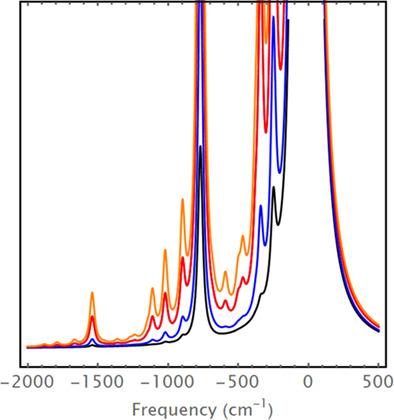当前位置:
X-MOL 学术
›
J. Comput. Chem.
›
论文详情
Our official English website, www.x-mol.net, welcomes your feedback! (Note: you will need to create a separate account there.)
Excited state distribution function for probing Herzberg–Teller vibronic coupling using linear optical response theory: Application to glassy pheophytin a
Journal of Computational Chemistry ( IF 3 ) Pub Date : 2021-07-26 , DOI: 10.1002/jcc.26724 Mohamad Toutounji 1
Journal of Computational Chemistry ( IF 3 ) Pub Date : 2021-07-26 , DOI: 10.1002/jcc.26724 Mohamad Toutounji 1
Affiliation

|
The goal of the present work is to develop an excited-state distribution function that can be used to calculate electronic transition dipole moment time correlation functions at a considerably low computational cost. An additional merit of the distribution function is its capability to probe the Hertzberg–Teller vibronic coupling effect in terms of the previously reported Condon correlation functions in the literature without having to start from the equilibrium density operator to probe spectral non-Condon effects, thereby exploring Hertzberg–Teller vibronic coupling by building on the Condon regime. It is easily extendable to anharmonic systems. Model calculations are reported to show the high degree of accuracy and computational efficiency of the presented approach. Application to a photosynthetic system such as pheophytin a in triethylamine is provided.
中文翻译:

使用线性光学响应理论探测 Herzberg-Teller 振动耦合的激发态分布函数:在玻璃态脱镁叶绿素 a 中的应用
目前工作的目标是开发一种激发态分布函数,可用于以相当低的计算成本计算电子跃迁偶极矩时间相关函数。分布函数的另一个优点是它能够根据文献中先前报道的 Condon 相关函数探测 Hertzberg-Teller 振动耦合效应,而不必从平衡密度算子开始探测光谱非 Condon 效应,从而探索Hertzberg-Teller 振动耦合建立在 Condon 体系之上。它很容易扩展到非谐系统。报告模型计算以显示所提出方法的高度准确性和计算效率。应用于光合作用系统,例如提供了三乙胺中的脱镁叶绿素a。
更新日期:2021-08-15
中文翻译:

使用线性光学响应理论探测 Herzberg-Teller 振动耦合的激发态分布函数:在玻璃态脱镁叶绿素 a 中的应用
目前工作的目标是开发一种激发态分布函数,可用于以相当低的计算成本计算电子跃迁偶极矩时间相关函数。分布函数的另一个优点是它能够根据文献中先前报道的 Condon 相关函数探测 Hertzberg-Teller 振动耦合效应,而不必从平衡密度算子开始探测光谱非 Condon 效应,从而探索Hertzberg-Teller 振动耦合建立在 Condon 体系之上。它很容易扩展到非谐系统。报告模型计算以显示所提出方法的高度准确性和计算效率。应用于光合作用系统,例如提供了三乙胺中的脱镁叶绿素a。


























 京公网安备 11010802027423号
京公网安备 11010802027423号